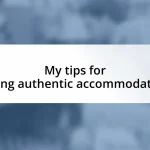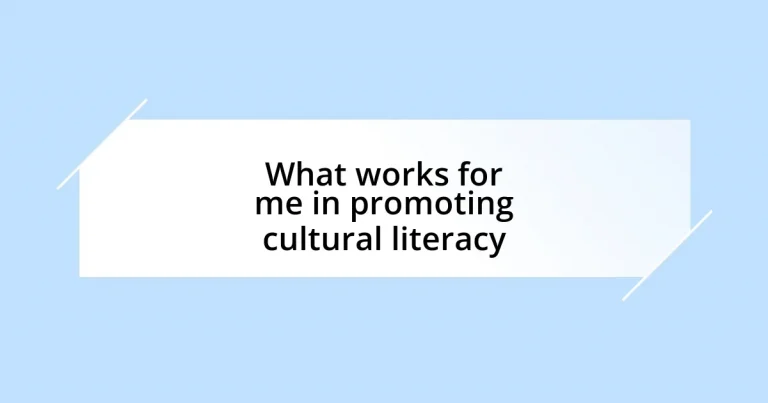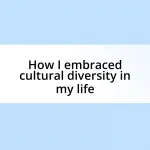Key takeaways:
- Cultural literacy fosters empathy, understanding, and creative problem-solving by connecting individuals from diverse backgrounds.
- Strategies such as storytelling nights, cultural exchange programs, and art exhibitions effectively promote cultural literacy and engagement within communities.
- Incorporating cultural activities in education enhances students’ appreciation for diversity through hands-on experiences and collaborative projects.
- Long-term sustainability of cultural literacy programs relies on community support, adapting to participants’ needs, and building partnerships with local organizations.
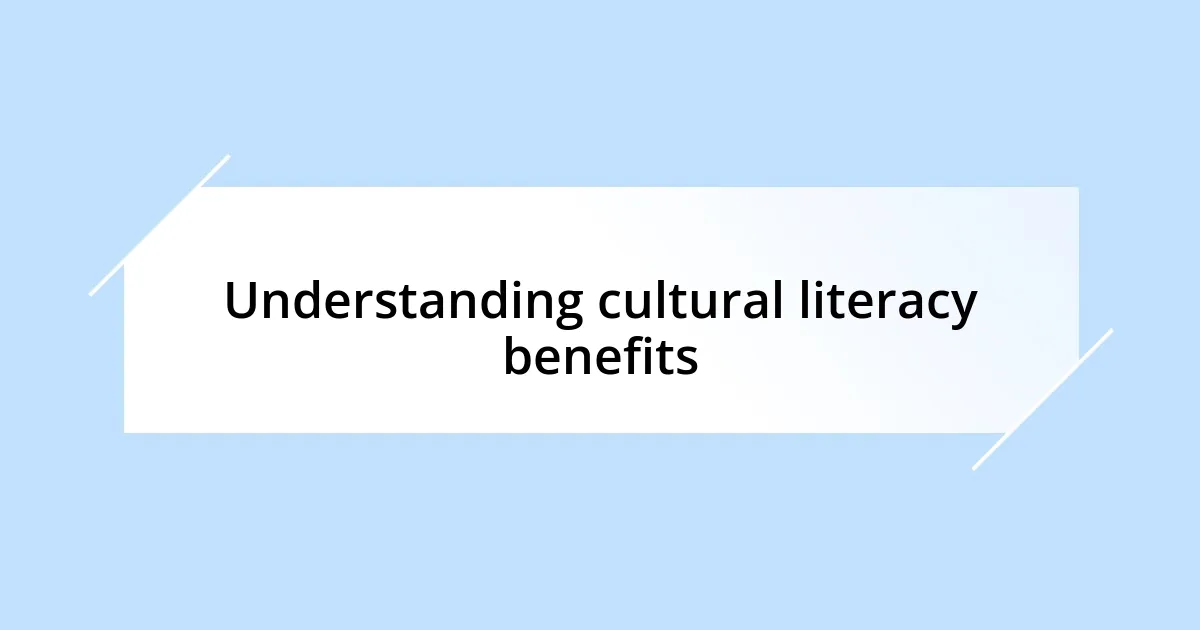
Understanding cultural literacy benefits
Cultural literacy opens doors to understanding diverse perspectives, which I realized when I attended a cross-cultural festival in my city. I remember interacting with someone from a completely different background, and as we shared stories about our traditions, I felt a connection that transcended our differences. This experience highlighted for me how cultural literacy not only enriches our own lives but also fosters empathy and appreciation for others.
Think about the conversations we often have. How meaningful can they be when we understand the cultural references and historical contexts behind them? I remember chatting with a colleague who made a joke about a popular film from his culture, and only after I researched it did I truly appreciate the humor and depth behind his words. This newfound knowledge not only improved our rapport but also made me feel more confident and engaged in discussions.
Moreover, cultural literacy enhances our problem-solving skills, as it encourages us to approach challenges from various angles. When I worked on a team project with individuals from different cultures, each team member brought unique solutions rooted in their cultural experiences. I found that embracing these differences led us to a thorough understanding of the problem and ultimately to a creative solution we couldn’t have achieved alone. Isn’t it fascinating how diverse backgrounds can lead to innovative ideas that benefit everyone involved?
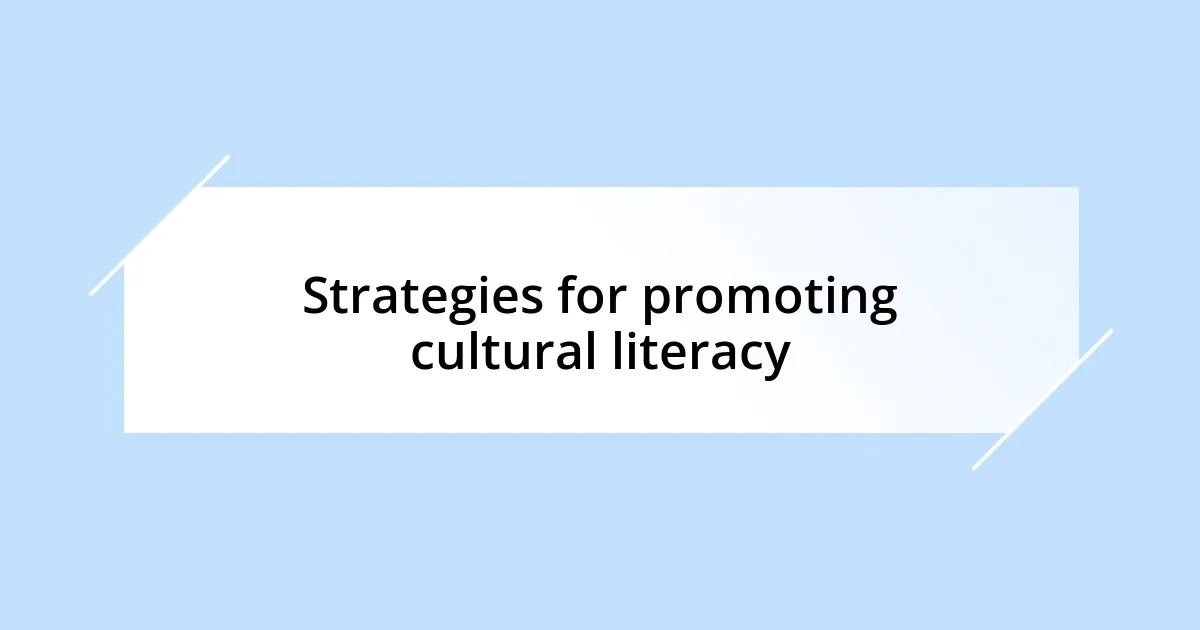
Strategies for promoting cultural literacy
Creating strategies to promote cultural literacy is crucial for fostering understanding and respect among diverse groups. One approach that has worked wonders for me is the integration of storytelling across cultures. I recall attending a workshop where participants shared folktales from their respective cultures. Listening to these stories not only captivated me but also deepened my understanding of the values and beliefs that shape different communities. It brought home the realization that stories are powerful tools for building bridges.
Here are some strategies I find effective:
– Storytelling Nights: Encourage individuals to share personal or cultural stories in a relaxed setting.
– Cultural Exchange Programs: Facilitate immersive experiences where participants live and learn within different cultures.
– Community Events: Organize festivals or fairs that celebrate diverse cultures through cuisine, music, and art.
– Interactive Workshops: Host sessions focused on traditional crafts or practices, allowing participants to engage and learn hands-on.
– Book Clubs: Select books from various cultures and foster discussions to explore themes and perspectives.
I’ve noticed that these activities spark curiosity and engagement. For instance, when I participated in a cooking class for Italian cuisine, the instructor shared anecdotes of family traditions tied to each recipe. This connection made the experience richer, making me more attentive and appreciative of not just the food, but the culture behind it. These strategies create meaningful experiences that not only teach but also inspire a love for diverse cultures, ultimately promoting cultural literacy.
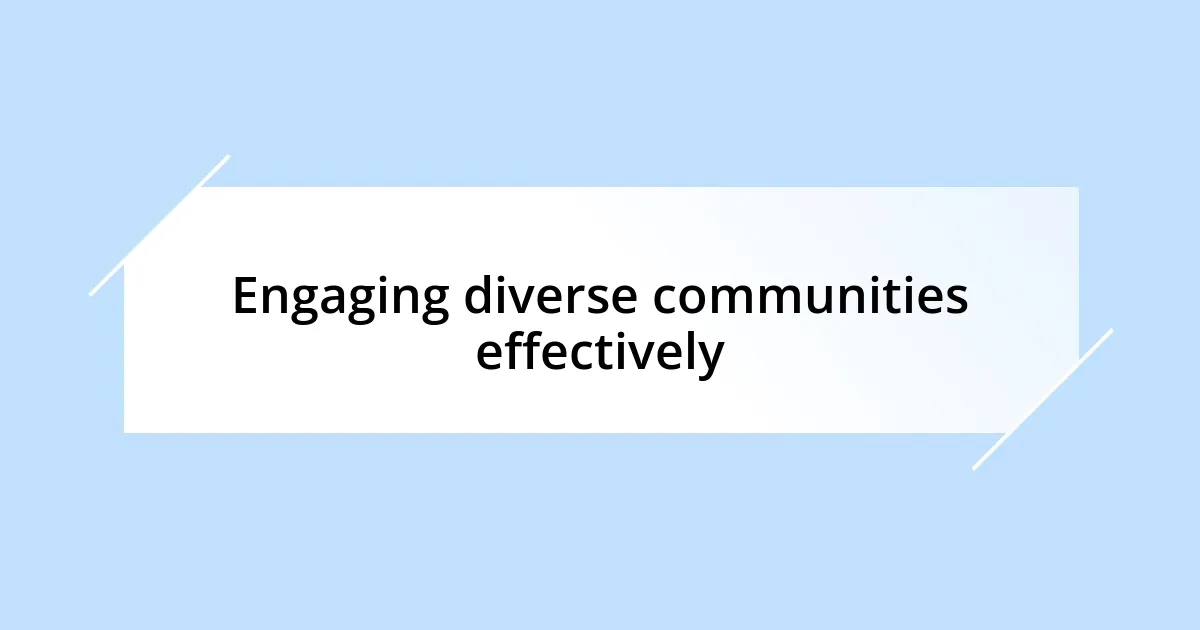
Engaging diverse communities effectively
Engaging diverse communities is a delightful challenge that can truly transform the way we interact. I recall a community meeting where we invited participants from various cultural backgrounds to share their perspectives on neighborhood improvements. The vibrant discussions that unfolded opened my eyes to innovative ideas that I had never considered before. It felt amazing to witness firsthand how different life experiences shape our views on community needs. This interaction not only fostered a sense of belonging but also strengthened our collective vision.
Additionally, using visual art as a medium can be incredibly effective in bridging cultural divides. I remember attending an art exhibition showcasing works from local artists of various backgrounds. Each piece told a unique story tied to cultural identities, allowing attendees to engage with those stories directly. This approach not only made the event memorable but also sparked dialogues among strangers who found common ground through art. Art has a remarkable capacity to evoke emotions and provoke thought, paving the way for deeper connections among diverse community members.
Building trust is fundamental when engaging with diverse communities. I learned this while volunteering at a local multicultural center. Initially, some community members were hesitant to participate due to preconceived notions about outsiders. However, through consistent and genuine interactions, we gradually established rapport. This experience validated for me the importance of patience and authenticity in cultural engagement. When we invest the time to connect meaningfully, we unlock the potential for mutual understanding and collaboration.
| Engagement Method | Impact |
|---|---|
| Community Meetings | Encourage shared perspectives and foster collective vision |
| Art Exhibitions | Facilitate emotional connections and spark meaningful dialogues |
| Consistent Volunteering | Build trust and establish lasting relationships |
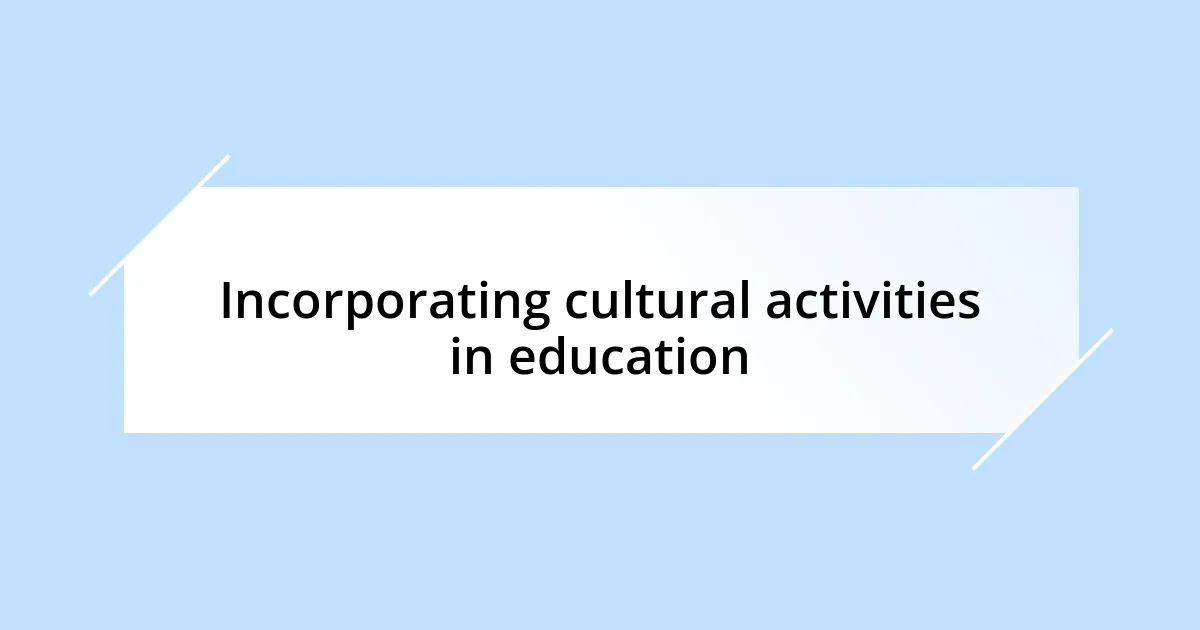
Incorporating cultural activities in education
Incorporating cultural activities into education offers students incredible opportunities for growth. One time, I organized a day where students experienced traditional dances from around the world. Watching kids try to mimic the movements, I could see their laughter turning into genuine curiosity about the cultures behind those dances. Isn’t it remarkable how movement and rhythm can convey the essence of a culture, opening doors to deeper understanding?
From my experience, a powerful way to incorporate cultural activities is through literature. I vividly remember hosting a reading session where students explored poetry from various cultures. As they voiced the words and feelings behind the verses, the room filled with a sense of connection and empathy. It got me thinking—how often do we overlook the emotional richness that literature can offer, creating bridges between our perspectives? It’s moments like these that remind me education isn’t just about facts; it’s about cultivating a heartfelt appreciation for diversity.
Art integration can’t be neglected, either. When I invited a local artist to lead a mural project reflecting our school’s diverse heritage, I watched students come alive with creativity and pride. As they painted side by side, sharing stories and inspiration, I realized that hands-on projects like this foster not just learning but genuine teamwork and respect. Could there be a better way to teach cultural literacy than through collaboration and artistic expression? Finding ways to blend cultural activities into education truly enriches the learning environment and empowers students to appreciate the world around them.
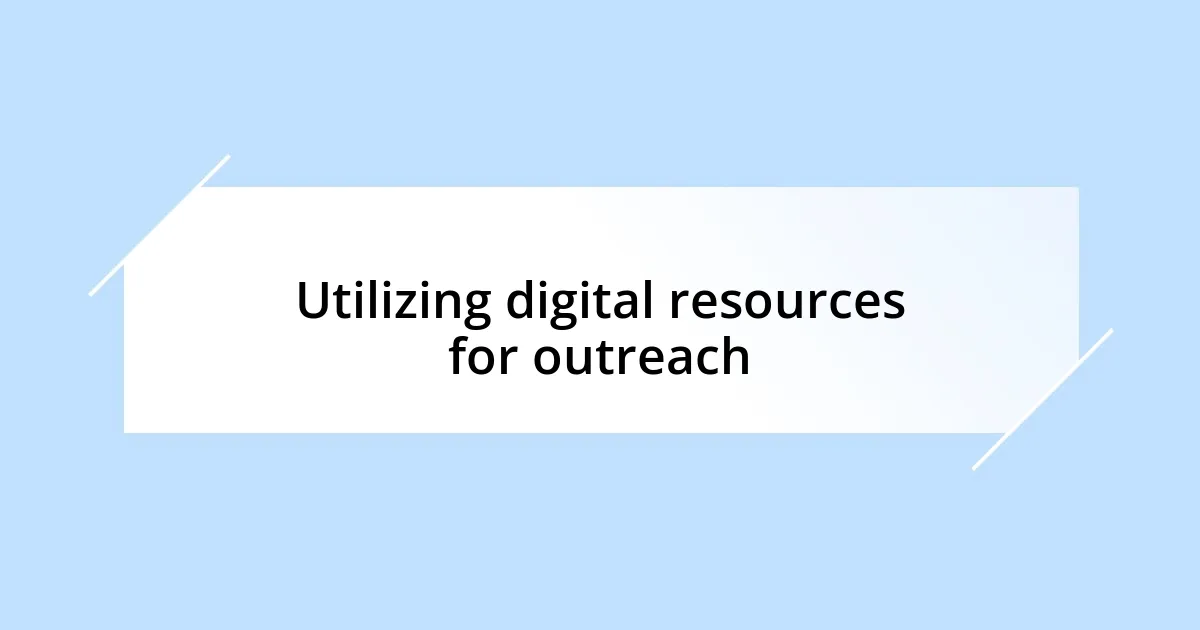
Utilizing digital resources for outreach
Utilizing digital resources for outreach has expanded my ability to connect with diverse communities in ways I never thought possible. I remember launching a virtual storytelling series on social media, inviting participants from various cultural backgrounds to share personal narratives. As they recounted their experiences, I realized how digital platforms could create a safe space for genuine dialogue, bridging gaps that traditional methods sometimes miss.
Moreover, I found that online workshops can significantly enhance engagement. One particularly memorable session involved a cooking class where participants prepared traditional dishes from their cultures via video. The joy and excitement in their voices as they shared recipes and culinary stories were contagious! Such experiences made me reflect on how food, often celebrated in person, can transcend physical barriers through digital connections, fostering understanding in a uniquely delightful manner.
I’ve also tapped into podcasts to reach even broader audiences. I recall hosting a podcast episode focused on cultural literacy, where I interviewed community leaders about their heritage and its impact on their work. Hearing their passion resonate through the audio waves sparked a fire in me—how powerful it is to listen to stories that might otherwise remain unheard! This underscores my belief that, with the right digital tools, we can create platforms for voices that deserve to be amplified, making cultural literacy an integral part of our collective narrative.
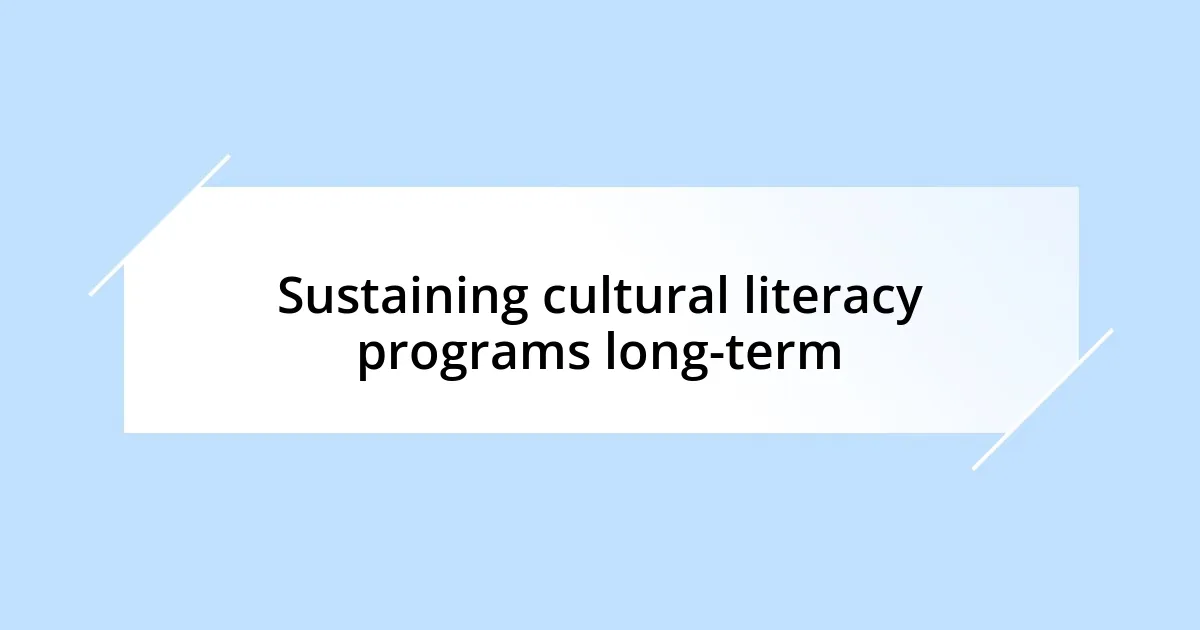
Sustaining cultural literacy programs long-term
Sustaining cultural literacy programs long-term requires a supportive community that sees the value in maintaining cultural initiatives. When I first started a cultural literacy club at our local library, I was surprised by the number of parents who wanted to be involved. Their enthusiasm not only showed me the importance of community backing but also transformed our monthly meetings into vibrant gatherings filled with shared resources and experiences. How often do we overlook the power of community collaboration in sustaining passion projects?
Another aspect that I’ve found crucial is regularly assessing the needs and interests of participants. Through informal surveys, I once learned that our storytelling sessions could greatly benefit from incorporating digital elements. This revelation allowed us to evolve and adapt, ensuring the program remained relevant and engaging. Is there anything more rewarding than watching a program grow because of honest feedback and a willingness to change?
Finally, long-term sustainability hinges on seeking partnerships with local organizations and schools. In my experience, when I reached out to universities for guest speakers, it not only enriched our program but also fostered a sense of shared responsibility for cultural education. Collaborating with others creates a network of support, and it begs the question: how can we pool our resources to create a more enriching cultural tapestry? By harnessing these relationships, we can ensure our cultural literacy programs thrive for years to come.

